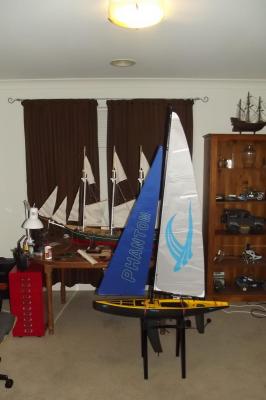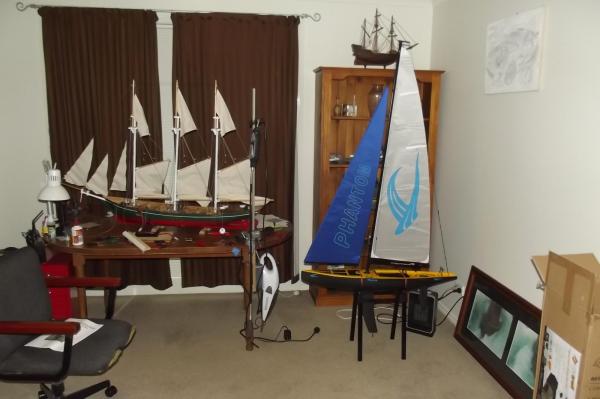-
Posts
1,283 -
Joined
-
Last visited
Content Type
Profiles
Forums
Gallery
Events
Everything posted by Bedford
-
Good question as weight is not scaled like length, as you say it is much less than 1/8 For anyone who doesn't understand consider a cube which contains 8 litres of water, to make it 1/8th scale you don't just remove 7 litres because this will only make it 1/8th in depth. You also need to remove width and length until they are 1/8th of the original measurement. so 8 litres of water weighs 8kg but at 1/8th scale it would weigh 0.0156kg. Hence my 1/8th scale rc Land Rover which weighs 3.5kg is about correct to scale even though the original weighs 1800kg not 28kg. The really tricky question is will the required weight of the flywheel scale down proportionally to the work it has to do? Or should I just sit back and enjoy what is sure to be a stunning build?
-
I hear you qwerty, the lake is about 130 metres wide and 3 or 400 long, most of each side is easily accessible but the dam wall end could be disastrous and the inflow end is all reeds etc so I would need a canoe to retrieve it from there. They do have some for hire at the lake. If she went down she would be lost forever. Check it out on google maps, Lake Canobolas near Orange NSW. I wish I had the kind of sailing lake Floyd has, 1 metre deep!
-
Well that was interesting, I just had my initiation to the joys of sailing. I took the Phantom out to the local lake because it is a fairly calm day. I found a spot where I had the breeze blowing towards me for the most part so if all else failed I reasoned that she would eventually be blown ashore. It didn't take long to learn how to tack her across the wind and I can lay claim to having her sail where I wanted her to, most of the time! There were occasions when the wind in the sails overpowered the efforts of the rudder so I will need to learn more about that. Also there was a while when she was into a head wind and only wanted to go forward, I couldn't get her to come about for a while but eventually she did. If it were the schooner I would have taken in sail and powered her around. Really glad I put auxiliary power in her! I also learned that the rudder I have for the schooner may be woefully inadequate so I will be looking into making a deeper detachable blade for that. I have been googling rc sailing in my area and there is no-one. I think I would really benefit from having someone experienced show me the ropes as it where. Either way, I need to learn a lot more about sailing on the Phantom before I wet the schooner.
-
Well for some reason I am apparently in a country that is FORBIDDEN from seeing the Port Carling sites ? That is the message I get. The launch is absolutely beautiful and I know you will do it justice, I am blown away by the fact that you intend to make a working model engine for it too. I am glued to the chair for this one. Steve
-
Floyd, $148 AUD delivered, and if it isn't a great performer who cares, I see it as virtually a disposable training vessel. There is a mob in Victoria that do a lot with these Chinese mid price sailers as they call them and there are all kinds of tips and mods I could do but probably won't unless I find it a lot of fun. I will however take a hint from what you said and silicone the keel in etc. As for scratch building such a vessel, can't see it in the foreseeable future, I am a classic sail guy. "Give me a tall ship and a star to steer her by" Having said that, never say never.
-
We've all heard of sail training ships, well here's mine. It's a bit back the front in so much as it isn't a tall ship but it was cheap, didn't require much setting up and I would imagine it will be a lot easier to learn to sail on than the schooner. Oh, and if it gets lost at sea, not so distressing ! It will also teach me about ballast and keel depth etc.
-
Mark, I am looking into various options but there is no point powering up the radio after the ESC as it isn't the drain, it is the limiting factor for the power to the radio and every digital servo adds to the power drain so it doesn't matter if I power them up one by one they will still over tax the system. The extra battery pack idea is apparently what the fly boys do with their big 1/4 scale planes with high power servos, they hook up a battery pack for every servo and since it all connects in parallel they provide built in redundancy because each battery pack powers the entire system. I don't want to go down that path for a few reasons :- First, every time I touch her she puts on weight and I doubt I will be able to put more than 1.5Kg of ballast in the sailing keel. Second, I have already invested quite a few $ in this and doing the extra batt pack idea will add quite a few to the tally. The battery pack I have fitted will be capable of supplying more than enough power to run everything but I need to find a separate way to supply a regulated 6V to the rx. I have considered ditching the current ESC which has two motor outputs and replacing it with two that have single motor outputs. This should double the power available to the rx but has the down side that the ESC's can't be guaranteed to be 100% balanced which could result in the schooner doing an imitation of the Bismark when she was beaten. There is a device called a UBEC which apparently does the job of the BEC (radio power supply) in the ESC and if I get one or two of these I can use them as well as the ESC power supply to feed the rx and they are much cheaper than batt packs. Does that make sense?
-
Ok boys and girls, tech talk time ! I have had more severe radio issues in that when I was setting up the winch servo for raising/lowering the stays'ls and I plugged it in to the receiver the whole on board system went berserk! The motors were going forward and reverse, the servos were going crazy ( the tops'l lazy jack master line broke again ) and the receiver was beeping and flashing. I asked the guys who have been following this build and know radio control what they thought and thank you all for your replies. Cap n Bob mentioned voltage among other things which got me thinking and from googling speed controllers I started to form a hypothesis. The power for the radio comes from a 7.2volt 2400mah battery pack via the electronic speed controller which controls the voltage to 6V for the radio. The problem is that the speed controller or ESC is designed for cars which may have two servos to run as well as the ESC so the output from the ESC to the radio just isn't putting enough power into the radio especially when I am running high torque digital servos which require constant power. The result is the same as any electrical circuit where you have too much load on the circuit, you end up with excessive voltage drop and nothing working properly. The cure, which I am yet to invest in is to add 6Volt battery packs to the servos, you can get "Y" leads which are normally used to run two servos on one channel but you can run one side to a servo and the other to a 6V battery pack. The power will feed into the receiver as well as the feed from the ESC thus boosting the power available to the servos. You can add a batt pack to one or all of the servo leads but I don't think I will need to add many. Feedback from Cap n Bobs old rc sailing club, although not saying this in so many words because they are not used to powering via an ESC, seems to confirm this hypothesis. For now I will disconnect all servos except the one I am setting up at the time. I realise that most of us who make rc sail boats won't fit auxilliary motors an therefore won't have the issues that arise from powering the system via an ESC but I thought it worth posting for posterity. Bob, you might wish to forward this on to your Indy buddies for their future reference along with my thanks.
-
I have replaced the broken master lazy jack with one of larger diameter to ensure it can't run off the spool on the servo. The original was thinner and could fit in the gap between the spool and the guide drum. By very gingerly turning it on and paying close attention to what happens I learned that the tops'l winch pulls on the lazy jack when the radio is turned on. It doesn't matter if the servo is all the way to it's preset stop in that direction it will still pull about 1/2 a turn more. Solution :- remember to always leave the tops'ls drawn out when turning the radio off, this way all it will do is pull the sail in a bit then return to the correct position without harming anything.
-
Michael, you wouldn't believe the strain the servos pull against to achieve all that. When I first tried raising the gaffs by pulling the halyards at the servo end I thought it would never work but was amazed at the torque of the servos. I have however encountered a small disaster. Last night I left her with tops'ls nicely pulled in but when I got up this morning I realised this could crease the sails so I switched on the radio and when I switched on the receiver the servos I have set travel limits on via the transmitter ran, searching for their limits and there was an almighty thump as the lazy jack final line from the connection of the three individual lines to the servo snapped under huge tension. I had feared this and am considering my options now. If I can find suitable switches I may switch off the servos individually and once the receiver has stabilised I will turn them on one by one, other wise I don't know how to overcome this problem. Any ideas........anyone???? Steve
-
Well Omega, it's like this. The lazy jacks which haul the gaffs down are attached to the sail at several points as in the real thing, kind of like a draw string. This keeps the sail nicely contained and controlled back to a bit past half way and while the balance of the sail can spill out it can't go far. So yes, I intend to at least motor out from the shore into open water before setting sails and I can choose how much sail to raise. If the wind comes up or my sailing skills let me down I can drop sails and power her home. If I were to sail on a windy day I would probably tie the tops'ls and stays'ls down to better control them.
-
Update, at last. As stated before the pipe work below deck is a pain but I have now completed all of it to the aft deck house. That includes raising and lowering the sails, tops'ls and controlling the sails. Next step is to raise, lower and control the stays'ls, this will be done from the fore deck house. Here is a little clip.
-
My two bobs worth.... It won't be very tall if you make it so the mast can be dropped which would be much easier than dislocating 40 oars. Build a shallow crate, like a big flat suit case, out of ply. Make it so you can secure the ship inside by keel mounting screws or clamps. Put it in, close the crate and you can tip it any way you need to and nothing can get to it. As for sweeping the oars further back than normal, I'm not sure how your set up will work but perhaps mounting the drive system on a sliding seat like that in a rowing boat would allow you to lock the drive mechanism in either of two positions, one for working and display and one where the oars are swept in for transit. Whatever you do I am keen to see her in action!
-
Michael, I just found this and read through it and I guess I can just refer you to almost every comment I have made on your 1/8th cutter. A few things that may be worth considering, I used to wind electric motors in another life and if you use a varnish coated wire of that small size you can very easily remove the varnish by running the wire slowly through a cigarette lighter flame, anything hotter will break the wire. Also I once made a very crude miniature of the "Schooner for Port Jackson" which I bottled, don't know where it got to, but I planked the deck by taking a very thin cut from soft radiata pine with a plane. It curls but if the blade is sharp and the cut is short it doesn't curl much, you can then use good sharp scissors to cut it into planks.
-
She dwarfs the motors, It sounds like you should have very nice speed control on the oars, I'm looking forward to action videos
-
I have been slack lately, not looking forward to the lazy jacks. I have sorted them now and I can now lower the sails properly. The video is a little bit dodgey as the camera kept trying to auto focus but it's ok. Once all the running rigging for the tops'ls is done I think it will be smoother and more controlled too.
About us
Modelshipworld - Advancing Ship Modeling through Research
SSL Secured
Your security is important for us so this Website is SSL-Secured
NRG Mailing Address
Nautical Research Guild
237 South Lincoln Street
Westmont IL, 60559-1917
Model Ship World ® and the MSW logo are Registered Trademarks, and belong to the Nautical Research Guild (United States Patent and Trademark Office: No. 6,929,264 & No. 6,929,274, registered Dec. 20, 2022)
Helpful Links
About the NRG
If you enjoy building ship models that are historically accurate as well as beautiful, then The Nautical Research Guild (NRG) is just right for you.
The Guild is a non-profit educational organization whose mission is to “Advance Ship Modeling Through Research”. We provide support to our members in their efforts to raise the quality of their model ships.
The Nautical Research Guild has published our world-renowned quarterly magazine, The Nautical Research Journal, since 1955. The pages of the Journal are full of articles by accomplished ship modelers who show you how they create those exquisite details on their models, and by maritime historians who show you the correct details to build. The Journal is available in both print and digital editions. Go to the NRG web site (www.thenrg.org) to download a complimentary digital copy of the Journal. The NRG also publishes plan sets, books and compilations of back issues of the Journal and the former Ships in Scale and Model Ship Builder magazines.





